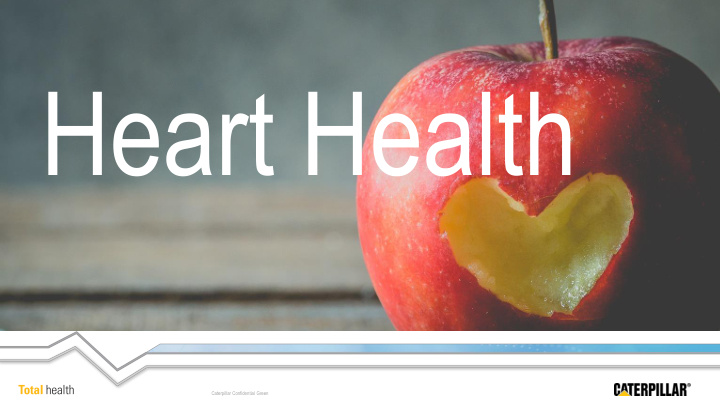



Heart Health Caterpillar Confidential Green
Objectives • What is Coronary Heart Disease (CHD)? • Causes of CHD • Who is at risk? • Signs and symptoms • Diagnosis • Treatment • Prevention Caterpillar Confidential Green 2
Coronary Heart Disease A disease in which a waxy substance called plaque builds up inside the heart arteries. These arteries supply oxygen- rich blood to your heart muscle. Over time, the plaque can harden, reducing the flow of blood to the heart. Image Source: Wikimedia Commons - BruceBlaus Caterpillar Confidential Green 3
Causes of Coronary Heart Disease (CHD) Research shows CHD starts when certain factors damage the inner layers of the coronary arteries. These factors include: • Smoking • High levels of fat and cholesterol in the blood • High blood pressure • High levels of sugar in the blood • Blood vessel inflammation Caterpillar Confidential Green 4
Major Risk Factors You Cannot Control • Age – 82% of deaths from CHD involve persons 65 years of age or older • Gender – Men are at greater risk than women • Heredity – Children of parents who have CHD are more likely to develop heart disease • Ethnicity – Higher numbers of African Americans have increased blood pressure, which can increase the risk of heart disease Caterpillar Confidential Green 5
Major Risk Factors You Can Control • Smoking – Smokers are 2-4 times more likely to develop CHD than non-smokers • High cholesterol – High cholesterol causes the arteries to narrow and blood flow to be slowed or blocked • High blood pressure – Increases the heart’s workload, causing heart muscle to thicken and become stiff • Physical inactivity – Regular moderate exercise helps prevent heart and blood vessel disease • Overweight – Increases the heart’s workload (at least 65% of people who develop high blood pressure are overweight) • Diabetes – Diabetes and heart disease go hand in hand Caterpillar Confidential Green 6
Other Risk Factors • Stress – Stress may affect behaviors and factors that increase heart disease risk, including high blood pressure and cholesterol levels, smoking, physical inactivity, and overeating • Alcohol – Excessive drinking can raise your blood pressure, cause heart failure, and lead to stroke • Diet – Excessive fat, fried foods, and sugar contribute to heart disease Caterpillar Confidential Green 7
Signs and Symptoms of CHD Angina • Angina is chest pain or discomfort • May feel like pressure or squeezing in your chest, shoulders, arms, neck, jaw, or back • Can often be mistaken for indigestion Shortness of Breath • Severity of symptoms may vary • May become more severe as the buildup of plaque continues to narrow the coronary artery Caterpillar Confidential Green 8
How is CHD Diagnosed? Your doctor will base your diagnosis on your medical and family history, your risk factors for CHD, physical exam, and results from tests and procedures. • EKG – A painless test that detects and records heart electrical activity. • Stress test – Typically involves walking on a treadmill, or taking medication to mimic the effects of physical exercise, while monitoring heart rhythm, blood pressure, and breathing. • Echo – Uses sound waves to create a moving picture of the heart. It also shows the heart’s size, shape, and how well the heart chambers and valves are working. • Blood tests – Checks for abnormal levels of fat, cholesterol, sugar, and protein in the blood. • Cardiac catheterization – Uses dye and special x-rays to show the inside of the coronary arteries Caterpillar Confidential Green 9
CHD Treatments Lifestyle changes, medication, and medical procedures. Goals include: • Relieving symptoms • Reducing factors to slow, stop, or reverse the buildup of plaque • Lower the risk of blood clots (blood clots can cause a heart attack) • Widen or bypass clogged arteries • Prevent complications of CHD Caterpillar Confidential Green 10
CHD Prevention Adopt a healthy lifestyle! • Follow a healthy diet – Whole grains, fat-free or low-fat dairy products, and lean meat • Maintain a healthy weight – Work with your healthcare provider or a registered dietitian to create a reasonable weight loss/maintenance plan • Get active – Aim for 20 minutes of moderate exercise every day • Stop smoking – Quitting can cut your chance of heart attack by 1/3 Caterpillar Confidential Green 11
Time is Muscle! The sooner medical attention is sought, the better the outcome after a heart event! Seek immediate help if you experience the below. Do not drive to the hospital — call 911! • Pressure or pain in the center of the chest • Pain or discomfort that spreads to the shoulders/neck/arms/jaw • Sweating, clammy skin, and/or paleness • Shortness of breath • Nausea or vomiting (women in particular) • Dizziness or fainting • Rapid or irregular heartbeat/pulse • Generalized feeling of fatigue (women in particular) • Indigestion (women in particular) Caterpillar Confidential Green 12
Any Questions? Caterpillar Confidential Green
Sources • OSF HealthCare (www.osfhealthcare.org) • National Heart, Lung, and Blood Institute (www.nhlbi.nih.gov) • American Heart Association (www.heart.org) Caterpillar Confidential Green 14
Caterpillar Confidential Green 15
Recommend
More recommend